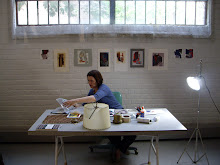The aim of art is to represent not the outward appearance of things, but their inward significance. Aristotle – Poetics
I seek to understand how art can capture the unconscious and metaphoric form and how this is transcribed and applied through the material and directly by the artist’s hand. I am interested in visceral space and how syncretic forms described by Ehrenzweig’s in the Hidden Order of Art as ‘poemagogic’ can be shaped by formalist principles and Plasticity. Drawing as a practise enables these cognitive and affective connections to be recorded directly and the immediacy and flexibility of the medium allows for the unconscious to be captured. I am interested in exploring abstraction in Matthew Collings’statement that ‘form is feeling’
My work has always been based on internal architectonic forms that relate to mood and remain as a residue of feeling. The space in my work is private, idealised and invites the viewer to enter through illusion, but passages create ambiguity. The content of my work is about capturing this feeling and I am curious to explore whether this felt internal space links with the concept of Poiesis and if this space that could possibility be Poemagogic and can be transcribed through Praxis and drawing.
Poiesis as a concept that links to Ehrenzweig’s ‘poemagogic’, ‘percepts’ and even what Diana Pethridge refers to as Deleuze and Guatari’s ‘Rhizomic model’ interests me. Poiesis as a word derives from poetry and to me this word has metaphorical and idealised formal connotations. This term was also utilised by Heidegger as a concept describing the ‘bringing forth’ process whilst creating an art work. There has been a longstanding relationship between Poiesis and Praxis since Aristotle and the term Poiesis is often used in science as meaning ‘creation, production’. I have an interest in Poiesis as a word that can describe metaphor and creation and Praxis as an application. Praxis links with materiality, Greenberg’s ‘media purity’ concepts and the medium being applied through action or marks or as a ‘verb’
My work is connected to formalism and modernism and I am interested in drawing in terms of what Diana Pethridge refers to in the Primacy of Drawing as ‘affective semiotics of design and composition’. I am also interested in how Kandinsky’s ‘necessity’ and purity of form can be formally organised though drawing and applied through the hand. My work is connected to Tachism, it is also connected to the Malevich’s ‘fourth dimension’ non-objective idealised concepts - but I seek to utilise formal devices through applying drawing principles. Drawing directly within painting and collages allows me to create compositions that are not pre-conceived. Drawing also allows a process to find the work and tap into what Ehrenzweig’s describes as’ 'polyphony' and 'poemagogic ' phantasy. Drawing can also construct space through erasure, collage and line and this direct medium often uses juxtaposing devices and visual tension and this becomes a spacial platform. This constructed space created through drawing is a visual pathway and the viewer can travel on Kandinsky’s ‘point, line to plane’. I have an interest in understanding how I can access and transcribe the unconscious ‘Hidden Order of Art’ through materials and plastic application of form. I am intrigued by drawing’s ability to be direct, immediate and ‘primal’ and translate the senses through the hand.

No comments:
Post a Comment